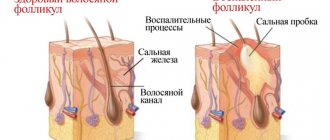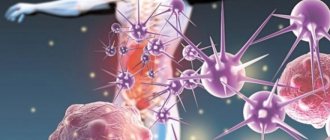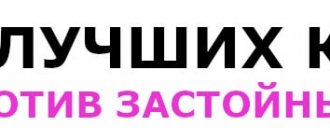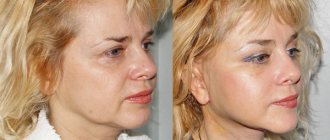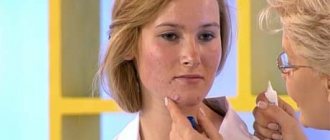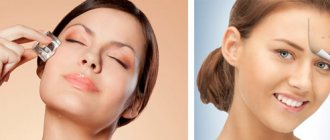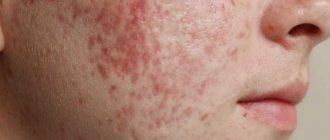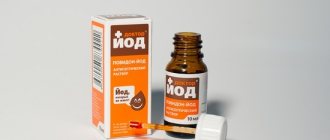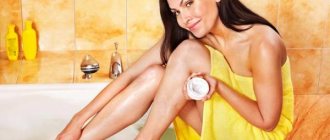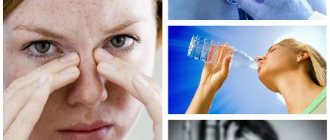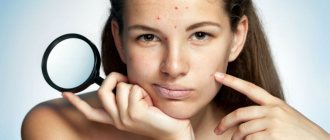The complex medical term “telangiectasia” is not so easy to remember, which is why we often hear the name “rosacea”. It refers to capillaries that have accumulated in some parts of the body and face; they can be visible on the skin even with the naked eye. Such red capillaries cause a lot of inconvenience. Those who have already encountered rosacea know that removing such capillaries from the face is somewhat difficult, and removing them is not the cheapest thing.
Causes of telangiectasia (rosacea) on the nose and cheeks
A course of treatment for a disease is prescribed only after the causes of the disease have been determined. Couperosis occurs most often in those who have white, thin skin, which is also extremely sensitive. The main reasons for this defect: hypersensitivity of the skin, a person’s predisposition to vascular fragility at the genetic level.
Various diseases of internal organs (liver, stomach), transformed from acute to chronic form, are also among the causes of the formation of redness of blood vessels in some areas of the skin. Weakening of the immune system in general, hormonal imbalances, along with significant stress, also cause the formation of red blood vessels in both adults and children.
Another reason is bad habits, as well as overeating; this is more common not in children, but in adults. An incorrect way of eating, a not very healthy way of life, and regular use of antibiotics are the key to the fact that dilated capillaries may appear in the nose and other places on the skin of the face. Removing such meshes and stars will not be an easy task.
External causes of the formation of redness on the cheeks and nose include aggressive climatic conditions - for example, significant frost, strong winds, hot sun.
Red capillaries that appear on a woman’s face hardly make anyone more beautiful, so an increasing number of their owners want to find an answer to the question: what is the best way to get rid of reddened capillaries? Cuperosis is a disease that is not easy to cure, so it is better to try to prevent its occurrence.
Those people who are naturally endowed with sensitive, thin skin should follow these rules throughout their lives, while those with normal skin prone to oily skin would do well to take into account how such a disease is treated.
To avoid the formation of red capillaries on the skin of the face, especially on the nose, as well as on the cheeks, you need to follow these simple tips:
No. 1. Eat a balanced diet.
No. 2. It is necessary to take care of your skin.
No. 3. Maintain good immunity in the body.
Removing manifestations of rosacea is a difficult, troublesome and expensive task, therefore it is best to prevent the disease.
What is rosacea?
Cuperosis is a common reason for visiting a dermatologist due to its aesthetic unattractiveness.
A bright blush on the face is considered a sign of health and attractiveness. However, causeless redness of the cheeks, forehead, and chin may indicate some problems with the skin of the face or the entire body.
A common reason for visiting a dermatologist is rosacea, a skin disease manifested by increased capillary fragility, causing redness to appear on the face.
At first, it accompanies staying in a hot room or in the sun, then it becomes a constant companion, and then telangiectasias appear - dark spider veins that are quite difficult to hide with decorative cosmetics.
It is the aesthetic unattractiveness of skin changes that brings representatives of the fair sex to a dermatologist or cosmetologist.
Stages of manifestation and symptoms of rosacea
The disease goes through three stages:
- Erythrosis - temporary redness of the face, “hot flashes” in moments of stress, against the background of a rise in temperature due to infectious diseases, when visiting baths, saunas, or prolonged exposure to the sun. It goes away independently and without a trace after the influence of the causative factor ceases.
- Telangiectasia is deformation of large capillaries directly under the skin. It has the appearance of a spider vein, stripes, and dots from scarlet to bluish in color. It is difficult to disguise even with a large amount of foundation. Once an asterisk appears, it cannot be removed at home.
- Rosacea is a pathological condition of the skin caused by long-term disruption of microcirculation and manifested by specific inflammatory changes - redness with compaction, pustular rashes.
The doctor will help determine whether the skin change is a manifestation of rosacea or another disease - telangiectatic disease, systemic lupus erythematosus, etc.
Even the second and third stages can be treated under the supervision of a specialist. Careful skin care will prevent the appearance of new vascular spots.
Causes of rosacea
Smoking, drinking alcohol and coffee can trigger the transformation of a predisposition to vascular fragility into rosacea
For the disease to manifest, a collision of two factors is necessary - genetic predisposition and adverse external influences on the skin.
When dilated red vessels are already present on the face: tips
Removing red capillaries from the skin of the face is quite difficult, and sometimes it takes a long time. A broken capillary is removed using expensive procedures in the salon - electrocoagulation, laser therapy, ozone therapy, and photorejuvenation.
Electrocoagulation is recognized as the most popular method to help eliminate broken blood vessels. The burst capillary is cauterized with a hair electrode. However, this procedure can, after resolving one of the problems, provoke another - resulting pigmentation, pinpoint scars.
Methods of professional treatment of rosacea and folk remedies
One of the ways to treat rosacea is laser therapy.
The doctor will prescribe vitamin preparations that improve the condition of the vascular wall - ascorbic acid, rutin, vitamin K. A diet with limited irritating foods and a sufficient amount of vegetables and fruits is recommended.
Cosmetology offers a number of procedures to get rid of vascular networks on the face.
- Electrocoagulation is a manipulation in which dilated capillaries are “cauterized” with a thin hair electrode.
- Laser therapy is the effect of laser radiation of a certain wavelength on dilated capillaries, which does not damage the surface layers of the skin. In this case, the walls of the capillaries seem to stick together, the blood flow in them stops, the vessel is replaced by light connective tissue without a noticeable scar.
- Ozone therapy is the introduction of an ozone-oxygen mixture into damaged capillaries using a thin needle.
- Photorejuvenation is the effect of light pulses on the problem area. Also used to eliminate age spots, acne and other skin defects.
- Darsonval is a type of physiotherapy that restores blood circulation in the affected area.
- Microcurrent lifting is a method similar to Darsonval.
All procedures are selected individually by a cosmetologist and require preliminary tests on an inconspicuous area of skin, since after exposure to the affected area, pigmentation (dark spots), new vascular spots or a scar may occur.
In this video, watch how the electrocoagulation procedure occurs:
How to remove red blood vessels on the face at home
- The first thing you need to do before you begin to cure rosacea at home is visit a doctor. Most likely, a visit to several specialists will be required in order to determine the cause of vascular problems. If the cause of rosacea is diseases of the internal organs, all physiotherapeutic, cosmetic, and other procedures will be ineffective until you cure the key disease.
- Along with the examination, it is necessary to adjust the diet and exclude from it those foods that can provoke the appearance of red blood vessels. Harmful products in this situation include various seasonings, dishes with a spicy taste, canned food, pickles, alcoholic beverages, including beer, even caffeine. It is necessary to greatly reduce the number of foods consumed with a high fat content: liver, cheeses, sour cream.
- Avoid alcoholic beverages and stop smoking.
- Treat the high blood pressure problem if present.
- Start eating foods that contain significant amounts of silicon. The leader in its percentage is Jerusalem artichoke. It is found in considerable quantities in beans, buckwheat, peas, as well as in oatmeal and corn. Porridges made from such products must be included in your diet every day.
- Increase your intake of foods with a high percentage of vitamin C, K, P. These will greatly affect the health of blood vessels.
- Play sports, lead a more active lifestyle, which helps get rid of excess cholesterol, improves the condition of the entire cardiovascular system, and reduces high blood pressure.
- Put aside cosmetics that contain alcohol or acetone. Perhaps you should use various facial scrubs less often.
- Try to minimize temperature fluctuations that affect the condition of your skin. This includes an extremely hot bath or sauna, a very hot shower, and severe frost. It's best to avoid them.
- Use sun protection and try not to be in it for a long time.
Mesotherapy
The mesotherapy procedure involves the introduction directly into the affected area of the skin of vitamin preparations, which help improve blood flow and reduce inflammatory processes. To achieve results, you need to undergo a course of injections, which usually consists of 10 sessions, once a week. Moreover, each procedure includes multiple injections, since it is necessary to administer 3 ml of the drug, 0.2 per injection. The advantage of this method is that, in addition to eliminating broken blood vessels, small wrinkles are smoothed out, skin turgor improves, and a healthy complexion appears.
Traditional methods for rosacea on the face
In addition to the actions that are aimed at getting rid of rosacea from the inside, described slightly above, you can use folk remedies for rosacea that will directly affect the skin of the face itself. There are many folk recipes, here are just a few of them that are the most effective:
- Brew chamomile (a few tablespoons) in 200 ml of water. When this infusion has cooled, filter it, then, moistening a cloth in it, apply it to the areas with redness for 10-15 minutes;
- Peel fresh potatoes and chop them with a blender or grater. Then make a potato mask and place it on your face for 10 minutes. After that, you need to remove it using the chamomile infusion described in the paragraph above. This is an extremely effective remedy for redness on the face;
- You can make a mask with the following composition: 1 teaspoon of potato starch, fresh sea buckthorn berries, lingonberries, raspberries, strawberries. Before applying the mask, you need to cleanse the skin of your face. The mask is applied for 20 minutes, then washed off.
In addition to these methods, the methods described here, you can use the large number of products that are offered on the market these days, but this will only be a cosmetic effect. If you start using only cream, it will not get worse, but the issue will not be resolved by itself. No one has yet invented a cure for rosacea that would help cure the disease once and for all.
Creams and ointments for rosacea
How to remove capillaries on the face? Unfortunately, the only method of completely eliminating the vascular network and preventing the re-development of rosacea is complex treatment of cardiovascular disease diagnosed by a doctor, which is the root cause of the expansion of capillaries on the face. But modern creams and ointments will help reduce redness and improve the appearance of the skin. They accelerate metabolic and regenerative processes in the skin, which helps reduce the appearance of the vascular network. Such drugs include:
- heparin ointment;
- "Ascorutin";
- "Troxevasin";
- Avene Diroseal cream;
- "Bioderma Sensibo";
- medicinal cosmetics "Lierak".
The result of using the rosacea cream is clearly presented in the photo.
Reasons for the appearance of a capillary network on the face
First of all, why does the face turn so red without adding beauty and aristocracy to a person? The problem mainly occurs due to the proximity of blood vessels to the surface of the skin, but may be related to health.
Dilated capillaries most often appear on the nose, cheeks and chin.
They occur when small vessels lose their elasticity due to poor circulation in the skin, expand and burst.
✔ Often, such vascular weakness is a hereditary problem for women and men with thin skin prone to allergies and irritations.
✔ Cardiovascular diseases and varicose veins, liver and digestive tract diseases also negatively affect the condition of blood vessels and capillaries, making them weak and brittle.
✔ Worse vascular function and hormonal disorders. Couperosis often occurs in women during periods when the balance of hormones changes dramatically, primarily during pregnancy and menopause, as well as when taking oral contraceptives.
✔ Wind, frost, stuffiness and heat also provoke rosacea. That is why dilated capillaries can be seen on the faces of workers in hot shops: steelworkers, cooks, bathhouse attendants, as well as on those who, due to their duties, spend a lot of time outside in the wind: traders, police officers. Isn't that why Santa Claus has a red nose? ✔ A sharp change in air temperature (from a steam room to an ice wormwood, wiping a steamed face with ice, from warmth to frost and vice versa). For vessels whose walls have lost their elasticity, this is detrimental.
✔ A person becomes “red-faced” even in moments of stress , because during an emotional shake-up, blood vessels contract and blood pressure rises.
Our doctors
Malakhov Yuri Stanislavovich
Doctor - cardiovascular surgeon, phlebologist, Honored Doctor of the Russian Federation, Doctor of Medical Sciences, doctor of the highest category
35 years of experience
Make an appointment
Konstantinova Galina Dmitrievna
Cardiovascular surgeon, phlebologist, Doctor of Medical Sciences, Professor
Make an appointment
Drozdov Sergey Alexandrovich
Cardiovascular surgeon, phlebologist, Doctor of Medical Sciences
Experience 46 years
Make an appointment
Cost of the procedure
The cost depends on the location of the defect and its area. Approximate prices for laser removal of blood vessels are shown in the table below.
Cost of laser treatment for telangiectasia on the face
| Processing area | Cost of 1 session |
| Wings of the nose | 2000 rubles |
| Cheeks | 3000 rubles |
| Full face and neck | 7500 rubles |
| Full face | 6200 rubles |
| Face, neck and décolleté | 8600 rubles |
Folk remedies for treating broken capillaries
Recipes for homemade masks and lotions based on the medicinal properties of plants will help reduce redness and improve the overall condition of facial skin. How to remove capillaries on the face using folk remedies? Here are some useful recipes:
- Lotions made from medicinal herbs: chamomile, calendula, string, horse chestnut, yarrow or green tea will noticeably reduce the appearance of burst capillaries.
- Use cosmetic clay as a face mask. But with rosacea, such a remedy cannot be covered with film. The warming effect will only worsen the condition of the blood vessels. Leave the mask in the open air until completely dry, then rinse with warm water.
- Various oils improve the condition of blood vessels. Mix a tablespoon of olive, grape, or flaxseed oil with starch or talcum powder until a thick mass is formed. Apply the mask for 15 minutes. Rinse with chamomile decoction.
- Badyaga effectively copes with facial redness. Dilute it with water to a paste and use as a face mask.
Both home and hardware methods for treating rosacea will not eradicate the problem, but will only eliminate the symptom in the form of unaesthetic manifestations. For a long-term effect, it is necessary to identify the root cause of the disease using medical diagnostic methods, undergo a course of treatment, and regularly take preventive measures. If even small capillary bruises occur, consult a specialist, as self-treatment can lead to the development of serious disorders of the body's cardiovascular system.
What diseases can rosacea prevent?
✔ Hormonal disorders: if spider veins appear simultaneously with a sharp change in body weight (you have gained or lost a lot of weight), unusual mood swings, sleep disorders or during menopause, it will not hurt you to consult an endocrinologist.
✔ Dysfunction of the sex glands can also provoke rosacea. It is worth visiting a gynecologist.
✔ Onset of hypertension. Contact a cardiologist or therapist if your blood pressure is elevated (140/90 mmHg), if the tonometer readings on both arms differ by more than 10, if the pressure changes over the course of one day.
You should consult a doctor even if you feel well. When the pressure normalizes, the rosacea network will decrease, and timely treatment will prevent heart attack and stroke.
✔ Inflammation of the sinuses. If rosacea occurs during or after a cold, your nose is constantly stuffy and snoring appears, you need to see an otolaryngologist.
✔ Couperosis can be a consequence of enterocolitis, dysbacteriosis, gastritis, varicose veins, liver diseases, allergies and many other pathologies in the body.
The rosacea mesh itself is not dangerous, but its location can seriously threaten health.
If it is located in the internal areas of organs: in the lungs, stomach, urinary tract, genitals, nasopharynx, etc., this creates a threat of internal bleeding.
Ways to get rid of spider veins on the face at home
You can get rid of redness in different ways.
Home remedies
- Contrast procedures. Washing with warm water and wiping the skin with pieces of ice will help with rosacea (infusions of sage and chamomile should be frozen).
- Tomato - a green tomato will effectively help remove spider veins and stars from the face. Its pulp must be applied to the face for fifteen minutes.
- Masks with badyaga also help get rid of vascular networks. It is necessary to dilute the powder in hot water to obtain a paste, then apply it to the skin of the face for twenty minutes.
- Juice from fresh burdock leaf. Squeeze out the juice, soak gauze in it and apply it as a compress, placing it on the face for fifteen minutes.
- Nettle. It needs to be brewed and cooled. Wipe the areas on the face where redness is present with the solution twice a day. The first procedure must be carried out before applying makeup, the second after removing it.
Wipe problem areas on your face with apple cider vinegar throughout the day.
Homemade masks will help you get rid of the capillary red mesh on your face:
1) Aloe : - aloe leaf - tea infusion Cut off the aloe leaf and keep it in the refrigerator for 2-3 days. Before going to bed, brew strong tea and rub it on your face. Then lubricate the problem areas with a cut aloe leaf. After drying, apply nourishing cream. A slight burning sensation may occur. If the burning does not go away within 2-3 minutes, then it is better to stop treatment. Repeat the procedures 10-12 times, every 1 day.
2) Parsley infusion
At the initial stages of the appearance of stars, you can try parsley infusion. It must be applied in the form of compresses to the affected areas; to do this, pour boiling water over several sprigs of parsley, then let it brew for about 20 minutes.
3) Parsley with milk : - 3 tablespoons of parsley - 0.5 cups of boiling water - 0.5 cups of milk Pour boiling water over the parsley (greens or roots) and leave for 15-20 minutes. Then strain and dilute with milk. Apply compresses to the face once a day for 30 minutes.
4) Ice cubes from herbal decoctions : - linden blossom - sage - calendula - green tea - yarrow - chamomile Take herbs in equal proportions. Pour boiling water, leave for 15 minutes and make compresses after 1 day, for 2 weeks.
5) Mask of freshly squeezed juice: - sea buckthorn - gooseberries - lingonberries - viburnum - cranberries - currants - strawberries - raspberries Squeeze the juice from the berries; if you have different berries, take them in equal quantities. Combine the juice mixture with starch in a 1:1 ratio. Apply the resulting mixture to your face for 15 minutes. Then rinse off the mask with warm water and apply moisturizer. Do this mask 2 times a week.
6) Mask for oily and porous skin: - 1 teaspoon lemon juice - 1 teaspoon cream Mix the ingredients and apply to the face for 15-20 minutes. Rinse off the mask with water at room temperature.
7) Clay mask: - 1 teaspoon lemon juice - 1 teaspoon cream - clay Mix lemon juice with cream, add clay. It should be a thick paste. Keep the mask on for 15-20 minutes, rinse with cool water.
Potato mask: with its help, our great-grandmothers fought with the vascular network on the skin. Potatoes have unique soothing properties and, when used correctly, will help reduce the symptoms of rosacea. Use fresh potatoes (no special heat treatment is needed) - peel them and grind in a blender until mushy. Apply the resulting mixture to problem areas of the skin with rosacea (10 minutes is enough), then carefully remove the potato residues with your hands. Wash your face with moderately warm clean water without rubbing the skin with a towel.
A mask based on glycerin and talc: a proven treatment for rosacea. It is recommended to use it before going outside during the cold season. The mask will help “neutralize” the effects of contrasting temperatures on blood vessels and skin. To prepare a mask, use vegetable oil, glycerin, talc, ready-made chamomile decoction: mix vegetable oil and glycerin (1 teaspoon of each ingredient), add a little talc (less than half a teaspoon, mix thoroughly and apply to problem skin. Wash off after 15 minutes chamomile decoction.
9) Cream with the addition of ascorutin: treatment of rosacea on the face with folk remedies involves not only the use of food and available ingredients. For this purpose, you can purchase the simplest baby face cream and mix it with crushed ascorutin tablets. The resulting product should not be kept in the refrigerator. It can be used as a replacement for your regular skin day cream.
9) Pleasant chamomile-based compress: chamomile has been used for rosacea for a very long time. Treatment with folk remedies without its decoction is almost impossible. It is used to wash off masks and as an independent remedy. Use dry chamomile. Pour boiling water (1 glass) over 2-3 tablespoons of chamomile, let the broth cool, then strain. Moisten a napkin or sterile gauze with the cooled and purified broth and leave on your face for about 15 minutes. Washing after the procedure is not advisable for some time. The healing properties of chamomile begin to act gradually.
But you shouldn’t “scrub” the skin with scrubs, gels and foams with an exfoliating effect. Vessels can burst if the skin is scratched or stretched. It is better to cleanse the skin with soft white clay and kaolin.
There is also such a simple recipe: brew a couple of tablespoons of dry chamomile in half a liter of boiling water, cool, strain, add 2 tablets of crushed ascorutin (vitamins C and P) and wipe your face with it several times a day
If you use such masks and compresses regularly, you can get rid of the vascular network easily and quickly enough.
Pharmacy cosmetics - anti-rosacea tonics, serums and creams will help with this problem only if they are used in courses.
Most often, doctors prescribe ointments and creams to their patients. Make sure they include: lemongrass, Japanese mint and rosemary. Most popular:
- cream "Bark";
- New Line cream;
- Bioderma Sensibio AR Cream;
- Janssen Vitaforce C Skin Complex cream;
- ointment "Rozamet";
- ointment “Cooperosis A+”;
- heparin ointment;
- ointment with oil and calendula extract.
You can get rid of the mesh at home, but you shouldn’t expect instant results - you need to be patient and then the result will not be long in coming.
Ways to get rid of rosacea on the face in beauty salons
If folk remedies do not have a visible result, then you can contact a cosmetologist who will offer you several options for getting rid of this problem.
Electrocoagulation , carried out in beauty salons, is ineffective and painful when the capillaries are dilated. After the procedure, you will have to sit at home for a long time, waiting for the scars and swelling to heal.
Peeling. If you are prone to rosacea, mechanical peels and fruit acids are harmful. Enzyme peeling is preferable - deep cleansing of the skin with plant enzymes. Conventional and vacuum cleaning are also not the best option. Better - ultrasonic cleaning.
Photothermolysis (vascular laser) and phototherapy will bring a more noticeable effect. The procedure takes a few minutes, no anesthesia is needed, and there is no recovery period required after it. The doctor selects the length of the pulsed light depending on the stage of rosacea. Under the influence of the laser, hemoglobin dissolves, the walls of the blood vessels stick together and go deep under the skin.
Ozone therapy is one of those methods that helps some, but becomes a waste of money for others. Cosmetologists find it effective only for mild rosacea. Ozone therapy does not leave scars, age spots, or skin defects. Using a microneedle, a mixture of ozone and oxygen is introduced into the vessels, which leads to the complete disappearance of the rosacea network from the skin surface.
Contraindications: myocardial infarction, thyroid disease, alcohol intoxication, diabetes.
A good cosmetologist will not hide the truth from the patient: it is better to remove dilated capillaries in the salon before the onset of severe cold and before hot weather approaches. The best time is in autumn and spring.
To consolidate the results, experts recommend courses of mesotherapy, lymphatic drainage massage and taking vascular-strengthening drugs.
Skin care features
Care for skin susceptible or predisposed to rosacea should take into account the fragility of blood vessels. They should not be stretched or shaken; blood circulation in them should be increased.
Cosmetic care also has its own characteristics. Not any cosmetics are suitable for her, but those that are marked “for sensitive skin”
Contraindicated:
- alcohol-containing and drying agents;
- procedures and components that enhance blood circulation;
- fruit masks and any products with fruit acids;
- contrasting washes;
- wiping areas with rosacea with ice;
- honey, menthol, aloe, eucalyptus, clove, anise, dill oils;
- film masks;
- masks with clay with caution - watch the skin reaction, it should not turn red;
- scrubs, peelings with coarse particles;
- chemical peeling;
- manual cleaning;
- steaming the facial skin, warming masks and compresses, hot inhalations;
- baths and saunas are possible only at minimum temperatures; the face must be covered with a damp towel;
- vacuum and manual massage.
Cosmetics should contain vascular-strengthening ingredients: extracts of wild myrtle, ginkgo biloba, cypress, galangal, blueberries, olives, mimosa, butcher's broom, kupena, sophora, green tea, horse chestnut, lemongrass, sweet clover.
Cosmetics for skin prone to rosacea should contain vitamins, primarily vitamins P, K, A, E and C - they strengthen the vascular walls. Well nourish and moisturize capricious skin with linoleic acid. And directly to areas with rosacea you need to apply a special cream with rutin, arnica extract, and vitamin C.
Daily care
✔ It is better to cleanse the skin with good quality basic oils. Grape seed oil, mixtures and infusions of oils are perfect. An infusion of avocado oil with calendula flowers is effective for evening cleansing of the skin.
✔ For washing, use herbal infusions of calendula, chamomile, yarrow, horse chestnut, and horsetail. ✔ Lotions made from these herbs are useful. Apply to the face for 20-30 minutes. The temperature of the infusion is room temperature. Soak gauze or cotton wool in the infusion and apply it to the face, only on problem areas. ✔ If you cleanse your face with oil , then washing should be of better quality than usual. You can soak the crumb of rye bread in the infusion for 10 minutes, then mash it with a fork and wash your face with this paste. If you have time, reapply and leave on your face for 5 minutes. The result is a toning and nourishing mask. For dry skin types, the crumb can be soaked in milk or cream. All skin types are suitable for sour milk (but not peroxided!) or kefir. Wash off the mask with boiled water or herbal infusion at room temperature, and gently pat the skin with a towel. Let your face and neck dry for 3-5 minutes and then apply a medicinal gel that strengthens blood vessels - Troxerutin - to problem areas. After absorbing the gel, complete the care by applying a moisturizing and nourishing cream.
Aromatherapy for rosacea
For weak capillaries, oils are needed to strengthen them: Essential: myrtle, cajuput, parsley, cypress, geranium, chamomile, immortelle, wild carrot, rose, tea tree, lavender, rosewood, neroli. Basic: almond, rosehip, avocado, jojoba, apricot, kukuya, macadamia, hazelnut, grape seed, tamanu, calendula oil infusions, borage oil, evening primrose. Essential oils of eucalyptus, cloves, anise, cinnamon and dill are not suitable A massage with rosewood oil in the collar area helps reduce the manifestation and stop the development of rosacea.
Advantages and disadvantages
An important advantage of fractional laser therapy over surgical methods of vessel removal (including minimally invasive endovasal laser obliteration) is the absence of a difficult rehabilitation period. The patient can do his usual activities and return to work duties the very next day after the procedure, while pain after using the laser is practically absent thanks to the use of modern radial light guides.
Radial light guides are used for laser removal of blood vessels.
Among the positive characteristics of laser coagulation, the following are also particularly significant:
- comfort for the patient (no severe pain during laser operation and during the recovery period);
- low likelihood of side effects and complications if you follow the technique of using the device, proper preparation and compliance with the cosmetologist’s recommendations after the procedure;
- Possibility of use in patients with any skin type;
- short duration of exposure (about 15-20 minutes);
- lack of invasive intervention, reducing the risk of infection;
- high performance.
During one procedure, the doctor has the opportunity to treat several areas or large areas at once, and in most cases the procedure does not require the use of general anesthesia, which is necessary when using surgical techniques.
The procedure causes minimal discomfort
Important! One of the undeniable advantages of laser coagulation using non-ablative fractional lasers is the absence of trauma to surrounding tissues (the light flux acts only on the vessel wall), as well as deep renewal and restoration of the skin due to the activation of regenerative processes.
Disadvantages of the method
In addition to a large number of advantages, removing blood vessels using a laser also has disadvantages, including:
- high probability of relapse. To prevent blood vessels from appearing on the face again, it is important to undergo a comprehensive examination and find out the cause of their occurrence. If all provoking factors are not eliminated, the risk of re-exacerbation of rosacea will be quite high;
- short term effect. If the patient takes hormonal medications, suffers from endocrine pathologies, liver diseases, systemic connective tissue lesions, the effect of laser coagulation will last for several months, after which the vessels may appear again (but the already treated capillaries will still be much lighter);
- the need to undergo a course of treatment. In most cases, 1 procedure is not enough to completely remove spider veins and spider veins, so the patient will have to visit the cosmetologist’s office several times.
In case of significant vascular damage, several courses of laser therapy will be required.
The disadvantages of the method include the rather high cost of the course, which can reach up to 30-45 thousand rubles.
Preventive measures
To prevent broken capillaries on the face from causing problems, you should wash your face only with warm water, and carefully wipe off excess liquid with a towel, without making any effort.
When visiting beauty salons, you must refrain from steaming procedures and deep peeling. Manual massage is also contraindicated for rosacea. In this case, it is better to give preference to phototherapy, thermal massage procedures and collagen masks.
Knowing what capillaries look like on the face, as well as the causes of the problem, you can follow simple rules:
- apply sunscreen before going outside;
- do not use cosmetics with abrasive particles and alcohol;
- eat right, exclude pickles, smoked foods, spicy, fried and fatty foods from the menu;
- give up alcohol and tobacco;
- play sports and be outdoors more often;
- If you are predisposed to rosacea, do not use deep facial cleansing or peeling.
 Potato mask: with its help, our great-grandmothers fought with the vascular network on the skin. Potatoes have unique soothing properties and, when used correctly, will help reduce the symptoms of rosacea. Use fresh potatoes (no special heat treatment is needed) - peel them and grind in a blender until mushy. Apply the resulting mixture to problem areas of the skin with rosacea (10 minutes is enough), then carefully remove the potato residues with your hands. Wash your face with moderately warm clean water without rubbing the skin with a towel.
Potato mask: with its help, our great-grandmothers fought with the vascular network on the skin. Potatoes have unique soothing properties and, when used correctly, will help reduce the symptoms of rosacea. Use fresh potatoes (no special heat treatment is needed) - peel them and grind in a blender until mushy. Apply the resulting mixture to problem areas of the skin with rosacea (10 minutes is enough), then carefully remove the potato residues with your hands. Wash your face with moderately warm clean water without rubbing the skin with a towel. 